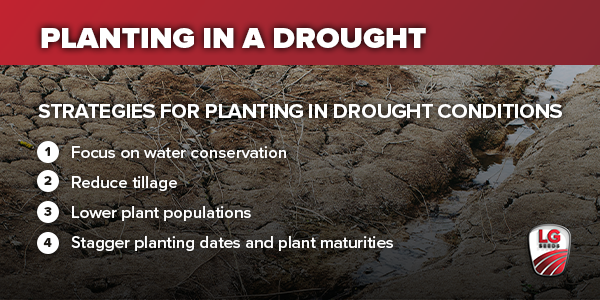AGRONOMICSUPPORT
YOU CAN TAKETO THE FIELD
Planting and Field Status Uncertain as Farmers Navigate Drought Conditions on the High Plains
The ongoing drought ravaging the Great Plains isn't exactly breaking news.
Adequate rainfall has been an issue since farmers first busted the sod. But in recent years, the incessant lack of precipitation has become a major issue for producers in the region.
Recent rainfall events have helped some, but vast swaths of Nebraska and most of Kansas are currently classified as experiencing "extreme" or "exceptional" drought.
And this situation is driving decisions.
As farmers continue to weigh their options, the reality is this—in some Midwestern acres, sorghum may replace corn, and some fields may simply be left fallow.
According to LG Seeds Agronomist Matt Teply, "Everything… comes back to water."
And as a guy who's spent his career helping farmers in the region, he offers some valuable insight into the current situation.
Minutes with Matt
"Every conversation we have in the High Plains is centered around water,” Matt said. “It's the most limiting factor in crop production in the West."
According to Matt, the lack of water hasn't delayed planting much this spring—although cold weather has certainly pushed things back in places. But the drought is obviously causing major issues.
"[The] biggest environmental effect of drought is an inability to produce crop biomass and, in turn, crop residue," he said.
Crop residue is essential—especially across the dry and windy Plains. Residue collects and retains moisture, acts as a weed barrier, and holds soil in place when wind speeds pick up (no need for a repeat of the Dust Bowl, please).
Speaking of wind, it can make a dry situation even drier.
As wind speeds increase, a plant's daily evapotranspiration (ET) rate also increases. Then as the ET rate increases (you guessed it), the plant uses even more water.
Water Conservation: Making the Most Out of What’s Available
Most of the water used by crops comes from the top three feet of soil. However, mature crops with well-developed root systems can reach down several more feet.
So what can you do to best use what little water is available?
"Reduce tillage and do everything to increase crop residue year in and year out," according to Matt.
He also notes that in some situations, lowering the plant population density might be necessary to reduce water. However, this will obviously affect your potential yield and ROI.
The bottom line? Specific advice depends on multiple factors and the intensity of each situation.
Minimum tillage and no-till are almost always sure ways to conserve water in your fields, but most dry-land farmers are already doing this.
When you've done all you can to optimize water usage, it's usually a good idea to spread out the risk. Start by staggering planting windows and planting seed varieties with different maturities.
By your side: No nonsense. No excuses.
The ongoing drought will likely cause significant challenges throughout the growing season, particularly among farmers throughout the Plains.
But LG Seeds is committed to your success—especially during the hard times. Reach out to your LG Seeds agronomist today, and let us help you make the best drought-ready decisions for your farm.






Agronomy Team